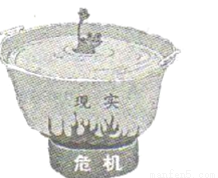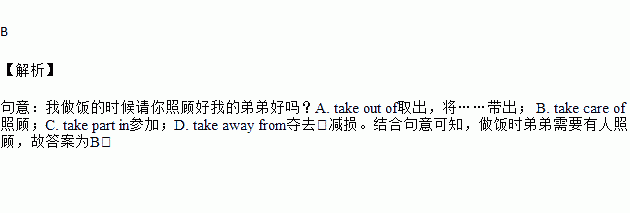��Ŀ����
Would you please ________my brother while I'm cooking?
A. take out of B. take care of
C. take part in D. take away from
 B
��������
���⣺��������ʱ�������չ˺��ҵĵܵܺ���A. take out ofȡ���������������� B. take care of�չˣ�C. take part in�μӣ�D. take away from��ȥ�����𡣽�Ͼ����֪������ʱ�ܵ���Ҫ�����չˣ��ʴ�ΪB��
B
��������
���⣺��������ʱ�������չ˺��ҵĵܵܺ���A. take out ofȡ���������������� B. take care of�չˣ�C. take part in�μӣ�D. take away from��ȥ�����𡣽�Ͼ����֪������ʱ�ܵ���Ҫ�����չˣ��ʴ�ΪB��

Put a frog in the water and start heating the water. As the
temperature of the water rises, the frog is able to adjust its body
temperature. The frog keeps on adjusting with the increase in
temperature.
Just when the water is about to reach the boiling point, the frog is not able to adjust anymore.
At that point the frog decides to jump out.
The frog tries to jump but is unable to do so. because it loses all its strength in
adjusting to the water temperature.
Very soon the frog dies. What kills the frog?
Many of us would say the boiling water.
But in fact, what kills the frog is its own inability to decide when it has to jump out.
We all need to adjust to people and situations, but we need to be sure when we need
to adjust and when we need to face.
There are times when we need to face the situation and take the proper action.
If we allow people to exploit us in body, mind, emotion or money, they will continue
to do so. We have to decide when to jump. Let us jump while we still have the strength! So, we must think of danger in times of safety and always be prepared for the worst.
1.What does the underlined word ��adjust�� in the first paragraph mean in Chinese?
A. ���� B. ���� C. ����
2.What kills the frog?
A. The boiling water.
B. Its own ability to adjust its body temperature.
C. Its own inability to decide when it has to jump out.
3.What does the writer really want to tell us?
A. We must think of danger in times of safety.
B. We should not put the frog in the boiling water.
C. The frog is too stupid to know how to protect itself.
 1.B
2.C
3.A
��������
���Ĵ��⣺���Ľ����ˡ���ˮ���� ���Ĺ��£�˵�����������Ҫ��ȡ�ʵ��ж��ĵ�����������ǣ������ڰ�ȫʱ�̿���Σ�գ���ʱ����Ӧ����������
1.���⣺��һ�λ��ߴʡ�adjust���ں�������ʲô��˼��������������⡣be able to do��������ij�£��հ״��Ƕ��ʣ�body temperature�����£����������ݾ��⣬��֪����...
1.B
2.C
3.A
��������
���Ĵ��⣺���Ľ����ˡ���ˮ���� ���Ĺ��£�˵�����������Ҫ��ȡ�ʵ��ж��ĵ�����������ǣ������ڰ�ȫʱ�̿���Σ�գ���ʱ����Ӧ����������
1.���⣺��һ�λ��ߴʡ�adjust���ں�������ʲô��˼��������������⡣be able to do��������ij�£��հ״��Ƕ��ʣ�body temperature�����£����������ݾ��⣬��֪����... ----Why don��t you play basketball with us?
----That��s not my cup of tea. I like reading at home better.
A. It's good for me.
B. I don' t want to drink tea.
C. It's my favorite.
D. It's not my favorite.
 D
��������
���⣺������Ϊʲô��������һ��������أ������Dz����ҵIJˡ��Ҹ�ϲ���ڼҿ��顣�����龰���ʡ��Dz����ҵIJˣ�����Ϊ�������������û��������ҵ�ij����������ҵİ��á���A. It's good for me.�Ƕ�����˵�ܺã�B. I don' t want to drink tea.�Ҳ���ȥ�Ȳ裻C. It's my favorite.�����ҵ����D. It's not m...
D
��������
���⣺������Ϊʲô��������һ��������أ������Dz����ҵIJˡ��Ҹ�ϲ���ڼҿ��顣�����龰���ʡ��Dz����ҵIJˣ�����Ϊ�������������û��������ҵ�ij����������ҵİ��á���A. It's good for me.�Ƕ�����˵�ܺã�B. I don' t want to drink tea.�Ҳ���ȥ�Ȳ裻C. It's my favorite.�����ҵ����D. It's not m... ������� ��ͨ������Ķ��ģ���������⣬Ȼ��������ĸ�����ѡ�����������Ӧ�հ״������ѡ�
It began a year ago, around Christmas. Every time I drove down our street, I noticed an old man sitting in his front yard. He was usually smoking or drinking, and looking rather unhappy.
One day, while I was driving past him with my , I decided to wave at him with a lot of excitement. , when he noticed me waving at him, he looked a bit surprised. Then, I saw his hand go up and he waved back.
�� did you wave at him?�� my daughter asked.
I told her it��s just an act of kindness that doesn��t anything. It gives both him and me a feeling of joy. My daughter replied that she felt a bit uncomfortable to wave to a stranger, but next time she would try it as well.
We lived close to the old man, we saw him rather often. Whenever we drove by, both of us would start waving at him and, pretty soon, the old man started at everyone who passed by his house.
One time, my daughter��s friend came to visit and she told my daughter that she saw this strange old man near our home wave at her very . She mentioned that she waved back, although she didn��t know him, and it felt really good.
As soon as my daughter heard this, she told her friend the of how all the waving began. Her friend answered, ��Tell your mom that��s really cool!��
Other friends gave similar . This taught my daughter that an act of kindness can be natural and , if you really want to do it. It showed us how giving happiness can do good to both the giver and the receiver.
1.A. husband B. son C. daughter D. friend
2.A. Just now B. On time C. In the end D. At the beginning
3.A. Why B. How C. When D. Where
4.A. buy B. cost C. hide D. guess
5.A. or B. but C.so D. yet
6.A. shouting B. waving C. laughing D. looking
7.A. angrily B. excitedly C. loudly D. carefully
8.A. lesson B. accident C. news D. story
9.A. gifts B. notes C. thoughts D. books
10.A. easy B. funny C. unusual D. special
 1.C
2.D
3.A
4.B
5.C
6.B
7.B
8.D
9.C
10.A
��������
������ƪ������Ҫ������һ�Ը�Ů�����һ����������ݴʣ���һ��ԭ�����۵����˿�ʼ�ֹ�����������Ӱ����һ�����ˡ�
1.1��C �������ʱ������ᄈ�����⡣���⣺һ�죬�Ҵ���Ů�����⾭����A.Husband�ɷ�B.son���ӣ�C.daught...
1.C
2.D
3.A
4.B
5.C
6.B
7.B
8.D
9.C
10.A
��������
������ƪ������Ҫ������һ�Ը�Ů�����һ����������ݴʣ���һ��ԭ�����۵����˿�ʼ�ֹ�����������Ӱ����һ�����ˡ�
1.1��C �������ʱ������ᄈ�����⡣���⣺һ�죬�Ҵ���Ů�����⾭����A.Husband�ɷ�B.son���ӣ�C.daught... �����ģ�The year of 2014 was a hard time to my friend Lin Mei��but she didn't________ hope.
A. pick up B. use up C. put up D. give up
 D
��������
���⣺2014����ҵ�������÷��˵��һ�μ��ѵ�ʱ�⣬������û�з���ϣ����A. pick up����B. use up�ù⣻C. put up����������D. give up��������Ͼ����֪����ΪD��
D
��������
���⣺2014����ҵ�������÷��˵��һ�μ��ѵ�ʱ�⣬������û�з���ϣ����A. pick up����B. use up�ù⣻C. put up����������D. give up��������Ͼ����֪����ΪD�� He used to________the guitar��but now he is more________in playing soccer.
A. plays��interested B. play��interested
C. play��interesting D. playing��interest
 B
��������
���⣺����ȥ�������������������������������Ȥ�ˡ�used to do sth.��Ϊ����ȥ������ij�¡���interesting�����interested�����ˡ�be interested in�ԡ�������Ȥ�����ݾ��⡰����ȥ�����������������������������������Ȥ����֪���ʴ�ѡB��
B
��������
���⣺����ȥ�������������������������������Ȥ�ˡ�used to do sth.��Ϊ����ȥ������ij�¡���interesting�����interested�����ˡ�be interested in�ԡ�������Ȥ�����ݾ��⡰����ȥ�����������������������������������Ȥ����֪���ʴ�ѡB�� When the school was over, I hurried back home to see my aunt Miss Lee. She just came back from __________yesterday. Miss Lee has been in America for about one year up to now. Every time when she tells us the__________ things she has experienced in that country, she will never __________to mention one thing that happened.
Miss Lee had an American friend Alice who lived in the same neighborhood. One day she paid a visit to her home. Miss Lee saw the __________son of Alice playing with toys in the room. She walked towards the little boy and patted him on the head__________. But Alice stood aside without a word and didn��t look happy at all. Miss Lee was very embarrassed at the time but did not know what__________
It was until one month later that Miss Lee began to know the__________. In China, to pat a person gently shows one likes the person. But in America, things__________to be quite different. They feel very __________when others pat them.
The story tells us that the__________body sign may mean differently in different countries.
1.A. America B. home C. China D. house
2.A. moving B. exciting C. interesting D. embarrassing
3.A. remember B. realize C. forget D. suffer
4.A. five years old B. five years C. five year D. five-year-old
5.A. heavily B. carefully C. gently D. rudely
6.A. caused B. produced C. made D. happened
7.A. reason B. test C. result D. game
8.A. be B. is C. are D. must
9.A. unhappy B. pleasant C. wonderful D. glad
10.A. same B. different C. good D. bad
 1.A
2.D
3.C
4.D
5.C
6.D
7.A
8.C
9.A
10.A
��������
�������߽����˹ù���Ůʿ�������������������飬������¸������ǣ�ͬ����֫�嶯�������ڲ�ͬ�Ĺ�����˼��ͬ��
1.���⣺������մ�����������A. America���ʣ�������B. home���ʣ��ң�C. China���ʣ��й���D. house...
1.A
2.D
3.C
4.D
5.C
6.D
7.A
8.C
9.A
10.A
��������
�������߽����˹ù���Ůʿ�������������������飬������¸������ǣ�ͬ����֫�嶯�������ڲ�ͬ�Ĺ�����˼��ͬ��
1.���⣺������մ�����������A. America���ʣ�������B. home���ʣ��ң�C. China���ʣ��й���D. house... Do you see many signs around you? Do you know the signs are an important part of our daily life? They can be in pictures or in words to give people information. What do people think are good signs? If you are thinking about making signs for others, what should you know?
The most important thing is that signs should be simple and easy to understand. It is important to use clear language. On the other hand, the words should be easy to write and you just need to write down what you want to do. ��Keep off the grass�� is a very good example. It means ��Don��t touch or walk on the grass��.
Nowadays, there is a saying that ��A picture paints a thousand words��. Perhaps that��s why we are seeing more and more signs in pictures, or a combination of pictures and words. However, that��s the difficult part, because picture signs may have different meanings in different countries.
1.First, a good sign should be ____.
A. clear B. beautiful C. funny D. interesting
2.The writer uses ��A picture paints a thousand words�� to show that ____.
A. a word sign is as easy as a picture sign to make
B. a picture sign often has more information than a word sign
C. a word sign has more information than a picture sign
D. a word sign and a picture sign have the same information
3.What does the underlined word ��combination�� mean?
A. �ֿ� B. ��� C. ���� D. ƽ��
4.What is the disadvantage (��������) of picture signs?
A. They are too simple.
B. They are not easy to understand.
C. They are not as interesting as word sign.
D. They may have different meanings in different countries.
5.What��s the best title of the passage?
A. Word Signs B. Picture Signs C. The History of Signs D. Signs Are Important
 1.A
2.B
3.B
4.D
5.D
��������
��ƪ�����Ѷ����У���Ҫ������־����Ҫ�ԣ���־Ҫ������������д������ͬ�Ĺ���ͼƬ���ź�����ܲ�ͬ��
1.ϸ�������⡣����The most important thing is that signs should be simple and easy to understand. It is important...
1.A
2.B
3.B
4.D
5.D
��������
��ƪ�����Ѷ����У���Ҫ������־����Ҫ�ԣ���־Ҫ������������д������ͬ�Ĺ���ͼƬ���ź�����ܲ�ͬ��
1.ϸ�������⡣����The most important thing is that signs should be simple and easy to understand. It is important... (2016���ϳ��п�)Jenny didn't go to bed her mother came home last night.
A. as soon as B. if C. while D. until
 D
��������
���⣺��������Jennyֱ��������ؼҲ�˯����as soon asһ���͡���if�������������״��Ӿ䣻while����ʱ��untilֱ����ʱ����仰�п����˾���not��untilֱ����ʱ�š�����ӦѡD��
D
��������
���⣺��������Jennyֱ��������ؼҲ�˯����as soon asһ���͡���if�������������״��Ӿ䣻while����ʱ��untilֱ����ʱ����仰�п����˾���not��untilֱ����ʱ�š�����ӦѡD�� 
